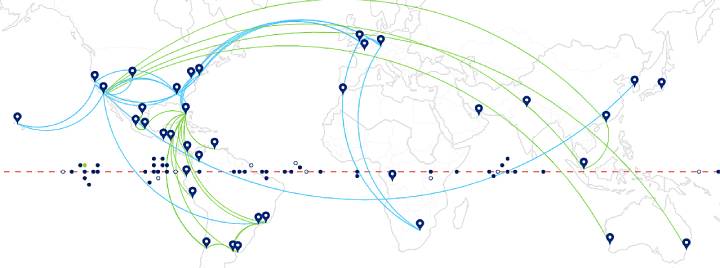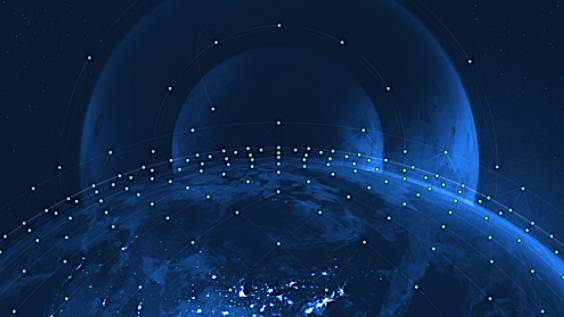 Intelsat has a fleet of 58 GEO-orbit satellites and has LEO partnerships with OneWeb and SpaceX Starlink. A MEO constellation is being studied. (Source: Intelsat)
Intelsat has a fleet of 58 GEO-orbit satellites and has LEO partnerships with OneWeb and SpaceX Starlink. A MEO constellation is being studied. (Source: Intelsat)
PARIS — Satellite fleet operator Intelsat spent so many years dragging a ball and chain of debt that it’s difficult to measure the remarkable turnaround — thank you Chapter 11, and thank you FCC C-band reallocation — that has made it once again a front-line player.
Here’s highlights of what the new Intelsat has done recently:
- purchased four software-defined, flexible payload satellites, two each from Airbus Defence and Space and Thales Alenia Space.
- doubled down on satellite in-orbit life extension with Northrop Grumman’s SpaceLogistics second-generation modules.
- helped create a new builder of small GEO-orbit satellites as the first buyer of the Swissto12 product.
- released bid requests for a constellation of MEO broadband satellites as part of a multi-orbit strategy.
- partnered with SpaceX’s Starlink broadband constellation to provide services to the U.S. government.
- invested in an in-orbit demonstration of space-to-ground optical communications links.
 Intelsat Chief Executive David C. Wajsgras. (Source: Intelsat)
Intelsat Chief Executive David C. Wajsgras. (Source: Intelsat)
Intelsat Chief Executive David Wajsgras said the company this year will be reporting top-line revenue growth for the second straight year, the first time that’s happened in a decade.
“By and large pricing has stabilized,” Wajsgras said here Sept. 11 during the World Satellite Business Week conference, organized by Euroconsult.
“In some cases there is still pressure. In other cases we are seeing opportunities for price economics. Given our operational cadence and strong execution over the last couple of years, with a strong balance sheet, we will be looking at a number of different opportunities to continue to grow the company.”
Civil government and military markets are an area of high growth as governments outsource services they used to develop on their own. It is this growth that led to an Intelsat agreement with Starlink.
“Starlink is first of all a formidable competitor,” said Bruno Fromont, Intelsat’s chief technology officer. “But they have several obvious weaknesses in terms of distribution.
“A broadband LEO system is very difficult to make profitable,” Fromont said in a Sept. 12 briefing on Intelsat’s strategy. “Elon Musk is not an exception to this, so in certain sectors they have solicited us because the level of service needed got be brought to customers, especially government customers. We have a lot of contacts with the U.S. government, after-sales service, software capacity, we have an agreement to package GEO and [Starlink] LEO, similar to the agreement we have with OneWeb.
“One network cannot service the breadth of all the possible services. You need to manage the strengths of each network. For defense, resilience is key and GEO proposes a security and service quality and cost per bit that is strong.”
Intelsat has a 58-satellite fleet that covers the world and the company presumably could open doors to Starlink among global governments, but the current agreement is limited to the United States, Fromont said.
Intelsat’s own multi-orbit strategy includes regulatory filings in medium-Earth orbit.
Intelsat said in June that it would solicit bids for an 18-satellite constellation — six satellites in three planes with a 60-degree inclination from 8,000 kilometers in altitude — to launch in 2027.
Wajsgras suggested it’s still not clear whether Intelsat will commit the capex needed.
“We are still continuing to do the business case, and seeing what might make sense for Intelsat and we will make that decision probably in the next 4-5-6 months. We are principally focused on two orbits [LEO and GEO]. Longer term, if we have a MEO constellation on orbit, there’s potential for that.”
 Intelsat Chief Technology Officer Bruno Fromont. (Source: Intelsat)
Intelsat Chief Technology Officer Bruno Fromont. (Source: Intelsat)
Fromont said the company is pursuing its consultations with prospective contractors on the MEO constellation.
Intelsat has conducted two satellite life-extension missions using Northrop Grumman Sapce Logistics Mission Extension Vehicles in 2020 and 2021, both of which were successful.
The company has purchased two second-generation vehicles, which Space Logistics calls Mission Extension Pods (MEPs).
Australia’s Optus fleet operator has purchased an MEP as well and all three will be launched together on a single vehicle in 2025, with the first docking with an Intelsat satellite in 2026, said Jean-Luc Froeliger, Intelsat senior vice president for space systems.
It remains unclear whether satellite life extension will find a market among operators of GEO-orbit satellites. Up to now, Intelsat has been the sole major customer. An expected order from the U.S. Defense Department to extend operations of one of its satellites has yet to come.
Among commercial operators, the move to all-electric satellites could make life extension less of an issue as electric propulsion already provides enough lifetime for most operators.
Froeliger disagreed, saying that electric satellites could be launched with less xenon for electric propulsion, saving mass to prove out a business. The owner then would use a life-extension service to refuel the satellite with xenon in orbit.
Northrop Grumman and Intelsat see satellite life extension as just the first business case for an emerging space robotics business.
Fromont said there are a couple of additional Intelsat satellites that could make use of the life-extension technology.
 Intelsat and startup Aalyria will launch a cubesat in 2024 to test space-to-groundoptical links. (Source: Aalyria)
Intelsat and startup Aalyria will launch a cubesat in 2024 to test space-to-groundoptical links. (Source: Aalyria)
Intelsat’s MEO constellation, if it’s contracted, would be fitted with laser communications to speed data transfers between satellites for faster delivery to customers.
But Fromont said the company has also concluded that optical transmissions from GEO orbit to the ground shows promise. It’s a matter of debate in the industry about whether the geographic separation of gateway Earth stations necessary given optical links’ trouble with clouds is worth the advantage of optical as a replacement for scarce radio frequency.
Airbus is testing its own space-to-ground optical technology, called Teleo, as a hosted payload on the Arabsat Badr-7 GEO-orbit telecommunications satellite.
Intelsat on Sept. 12 announced an agreement with startup Aalyria, founded with technology coming from Google, to launch a small satellite into low Earth orbit in 2024 to test Aalyria’s technology.
“Three years ago I was not convinced about the space-to-ground part because of the challenges in getting around clouds,” Fromont said. “But Aalyria has developed technology that we can connect the ground directly with laser.
There is a cost element but the domain is developing very quickly, with an extremely interesting technology. It’s a preliminary agreement, but the testing they did on the ground worked very well.”
Read more from Space Intel Report.
